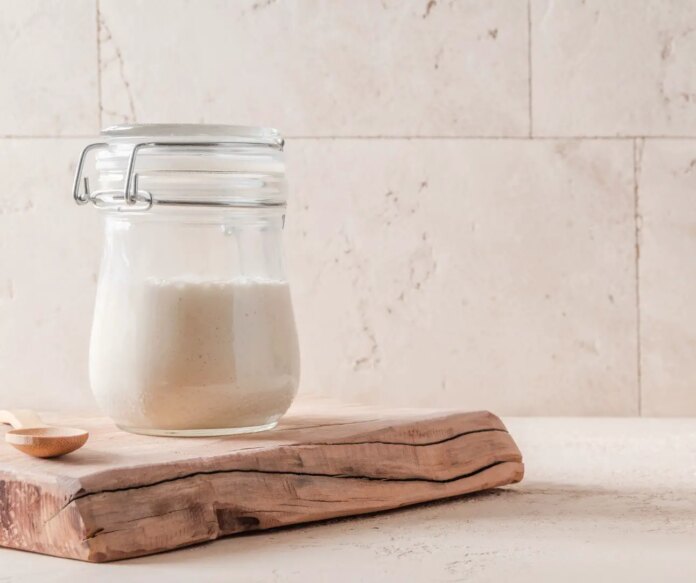Attaining a bubbly, balanced liquid sourdough starter could seem formidable to novice bakers, however it’s simpler than you assume. This information will stroll you thru make liquid sourdough starter from scratch with only a few easy components and a little bit of endurance – no earlier bread-baking expertise required.
You’ll study suggestions for capturing wild yeast, sustaining the correct setting, and telling when your starter is able to leaven loaves. Let’s begin!

Desk of Contents
What’s a Liquid Sourdough Starter?
A liquid sourdough starter, typically referred to as a moist starter or batter starter, is a kind of starter used for baking sourdough bread. Because the identify suggests, liquid starters have a thinner, extra fluid-like consistency in comparison with conventional agency starters.
The primary distinction lies within the hydration degree, which refers back to the ratio of water to flour within the starter. Liquid starters sometimes have a hydration degree of 100% or increased, that means the burden of the water equals or exceeds the burden of the flour.
For instance, a typical liquid starter recipe requires equal weights of water and flour at 100g every to realize 100% hydration. The excessive moisture content material provides liquid starters a free, batter-like texture that pours easily as an alternative of holding a stable kind.
Liquid sourdough starters supply some benefits:
- The elevated hydration creates an excellent setting for yeast and useful micro organism to thrive and produce extra acids and gases. This further carry provides the bread a lighter, airier crumb.
- The free texture incorporates air bubbles simply when combined into the dough, boosting rise.
- Increased moisture starter blends easily into doughs, permitting residence bakers to experiment with moist, sticky doughs that swimsuit artisan loaves.
So in abstract, liquid sourdough starters have a wetter, extra fluid consistency because of elevated hydration ranges. This boosts the starter’s exercise and provides it distinctive properties fitted to particular bread recipes.
Advantages of a Liquid Starter
A liquid starter is healthier than a stiff sourdough starter due to its excessive water content material. As a house baker, I’ve tried each and located that moist starters make higher bread.
Extra Taste
The additional moisture permits extra fermentation. This ends in extra acidic flavors that give bread complexity. My tastiest artisan loaves used a liquid starter within the dough.
Lighter Bread
The skinny, batter-like liquid starter mixes air into the dough properly. Totally proofed bread seems with a pleasant carry and light-weight texture. With follow, you will get massive irregular air pockets within the crumb. Liquid starters assist make that rustic take a look at residence.
In brief, liquid starters enhance taste and make lighter, airier bread than agency starters. The moisture unlocks properties that take your loaf to the following degree. I recommend making an attempt a moist starter on your subsequent selfmade bake!
Gathering Your Provides
To make a liquid sourdough starter from scratch, you’ll want a couple of easy components and kitchen instruments. Let’s take a fast take a look at the necessities.
Complete Grain Flour
The bottom of your starter is 100 grams of unbleached entire grain flour – sometimes entire wheat. The pure yeast and micro organism current assist kickstart fermentation.
Filtered Water
Use 100 grams of lukewarm filtered water, not faucet water, which inhibits fermentation. The starter prefers pure H2O at room temperature.
Jars and Different Provides
You’ll want a glass jar or container to accommodate your new starter and permit it to double or triple in dimension. A digital kitchen scale helps weigh out flour and water quantities exactly. And also you’ll want a clear spoon for stirring.
That covers the core components and quantities! With:
- 100 grams of whole-grain flour
- 100 ml of filtered water
- a 1-quart glass jar
- digital scale
- spoon
… you may have every part wanted to combine up a selfmade liquid sourdough starter. The straightforward components are simple to collect from a well-stocked baker’s kitchen. Now the enjoyable begins!
Step-by-Step Directions
Day 1
- Mix 100g entire wheat flour and 100g filtered water in a jar
- Combine properly till totally included right into a free, thick batter
- Cowl the jar loosely and let sit at room temperature for twenty-four hours
Day 2
- Take away and discard half the starter (about 100g)
- Add 50g entire wheat flour and 50g filtered water
- Stir properly till totally blended and clean
- Cowl and let sit at room temperature for twenty-four hours
Day 3
- Take away and discard half the starter (about 100g)
- Add 50g entire wheat flour and 50g filtered water
- Stir to mix and canopy loosely
- Count on to see some bubbles on the floor!
Day 4
- Discard half the starter (about 100g)
- Add 50g entire wheat flour and 50g filtered water
- Stir, cowl, and ferment for twenty-four hours
Day 5
- Discard half the starter (now frothy and expanded)
- Add 50g flour and 50g water, combine and canopy
- Let double in dimension at room temperature
Day 6
- Discard half the starter
- Feed with equal weights of flour and water
- Indicators of fermentation needs to be noticeable!
Day 7
- Discard half, feed remaining as earlier than
- Your starter needs to be bubbly and pungent
- It’s prepared to make use of in baking!
The best way to Velocity Up the Sourdough Starter Course of
Preserve Your Starter Heat
Sourdough starters develop finest between 75-85°F. Preserve your starter at a heat room temperature as a lot as doable through the first week. You may place the jar close to a heat equipment like an oven or on a heating pad on low. The heat quickens fermentation, reducing activation time.
Use Rye and Complete Wheat Flour
Combining rye flour and entire wheat flour kickstarts starter exercise sooner than different flours. Rye accommodates enzymes that increase fermentation whereas entire wheat feeds wild yeast properly. Combine 100g every of rye and entire wheat flour with 100g filtered water to make your starter.
Improve Feeding Frequency
As an alternative of feeding your new starter as soon as each 24 hours, attempt feeding it 2-3 occasions per day. For instance, feed within the morning, afternoon, and night. The additional feedings speed up bubble manufacturing, leading to an energetic starter in simply 3-5 days. Then resume day by day feedings.
Troubleshooting Widespread Points
Making a liquid sourdough starter from scratch entails cultivating yeasts and micro organism to provide a energetic, bubbly combination good for baking. Nevertheless, learners typically encounter some widespread hiccups. Right here’s assist figuring out and resolving three typical starter issues.
Coping with Mildew
You might discover fuzzy mold rising on the starter’s floor or sides of the jar. This means undesirable micro organism infiltrated the ecosystem. Scoop out and discard the mould, washing the jar with scorching soapy water. Then rebuild your starter from scratch with contemporary components in a sanitized container to manage contamination. Feed a brand new starter day by day till energetic once more.
Managing Extra Alcohol (Hooch)
In case your starter separates with a layer of pale yellow liquid on high, this “hooch” is extra alcohol from over-fermented yeast. Stir it again in, discard half the starter, and resume feedings with common quantities of flour and water. Frequent feedings forestall the yeast from producing an excessive amount of alcohol.
Boosting Fermentation
In case your starter isn’t effervescent or doubling in dimension after feedings, the yeast may have a bounce begin. Attempt stirring in a teaspoon of contemporary energetic starters from a buddy to introduce extra wild yeast. Swap up your flour and use filtered water to reboot sluggish fermentation. Pay shut consideration to feedings till the starter perks up.
Upkeep and Storage
As soon as your liquid sourdough starter is bubbly and energetic, you’ll wish to maintain it wholesome for ongoing baking. Correct sourdough starter upkeep is vital for longevity.
As an enthusiastic residence baker, I favor to bake weekly or extra typically. However life typically will get busy. Fortunately, liquid starters deal with interruptions of their feeding schedule fairly properly.
Refrigeration Lets Starters Relaxation
For breaks of per week or longer with out baking, refrigerate your starter. The chilly setting dramatically slows fermentation to a close to halt. This lets wild yeasts and micro organism go dormant with out dying off.
To retailer, discard half the starter as ordinary, feed the rest, combine properly, and loosely cowl. Place it behind the fridge furthest from the door. Refrigeration preserves starters for at the least a month earlier than feeds are wanted.
Reviving Chilled Starters
Take away starters from the fridge a day earlier than baking to allow them to get up and regain exercise. Discard half and refresh with equal weights of flour and water.
Inside 8-12 hours at room temperature, chilled starters double in dimension and develop into bubbly once more. The wild yeasts and micro organism revive to full fermentation energy. Then your refreshed starter is able to leaven dough.
In abstract, refrigeration helps you to safely retailer liquid sourdough starters for weeks between bakings. And reviving dormant chilled starters is a cinch.
Wrap Up
Liquid sourdough starters are an accessible entry level for aspiring bakers to make artisan sourdough bread at residence. Their skinny, batter-like texture encourages vigorous fermentation for max rise and complicated taste in comparison with firmer starters. With step-by-step steering, learners can combine, feed, troubleshoot, and preserve bubbly selfmade starters able to leaven a wide range of doughs. Placing this energetic leavening agent to work unlocks sourdough’s full potential proper in your kitchen.
FAQs: The best way to Make Liquid Sourdough Starter
How do you make a liquid sourdough starter?
To make a liquid sourdough starter, combine collectively equal components flour and water by weight (100% hydration) and let it ferment for 3-5 days, feeding it day by day with equal components flour and water till it’s bubbly and bitter smelling.
What’s the distinction between stable and liquid sourdough starter?
Stable sourdough starter has a decrease hydration degree (round 50-75%), leading to a thick, dough-like consistency, whereas liquid sourdough starter has 100% hydration for a batter-like consistency that flows extra simply.
Is sourdough starter simply flour and water?
No, primary sourdough starter components are flour and water however a pure yeast referred to as lactobacilli types from the air and ferment the flour and water combination right into a bubbly sourdough starter over 3-5 days with correct feeding.
How do you make a 100% hydration sourdough starter?
To make a 100% hydration liquid sourdough starter, mix equal weights of flour and water in a jar, combine, cowl loosely, and let ferment for 3-5 days, feeding it day by day with equal components flour and water.







